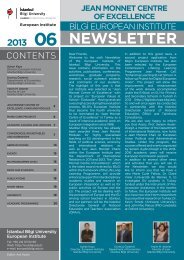WP2 Turkey: Country Report - İstanbul Bilgi Üniversitesi | AB Enstitüsü
WP2 Turkey: Country Report - İstanbul Bilgi Üniversitesi | AB Enstitüsü
WP2 Turkey: Country Report - İstanbul Bilgi Üniversitesi | AB Enstitüsü
You also want an ePaper? Increase the reach of your titles
YUMPU automatically turns print PDFs into web optimized ePapers that Google loves.
Social Impact of Emigration and Rural-Urban Migration in Central and Eastern Europe<br />
VT/2010/001<br />
Quite a number of Arab origin Turkish citizens also left <strong>Turkey</strong> to work abroad in the 1960s<br />
and 1970s. Arabs mostly migrated to the big cities like Istanbul in 1950s and 1960s to take<br />
part in the trading segments of the cities such. The remaining parts of the Arab population<br />
also preferred to go to the big cities (Istanbul, İzmir, Mersin, Gaziantep and Adana) since the<br />
1980s following their predecessors due to their demographic disadvantage vis-a-vis the<br />
Kurds. Fahri Aral, the chief editor of Istanbul <strong>Bilgi</strong> University Press, claims that the main<br />
survival strategy of the Arabs in the urban space was rather to assimilate into the<br />
mainstream Turkish culture and to identify themselves as Turkish (personal interview with<br />
Fahri Aral, 10 August, 2011).<br />
Alevis: Most of the Alevis are of Turkoman origin. The Alevi population is divided into four<br />
categories on the basis of the language they speak. The total population of Alevis living in<br />
<strong>Turkey</strong> is approximately 12 million, consisting of: 1) Alevis who speak the Azerbaijani dialect<br />
of Turkish. Their religious belief and practice is similar to the Shia religion in Iran. They live in<br />
Kars and constitute a small number of the population; 2) Alevis who speak Arabic (see<br />
above). Arab Alevis originate from the Nusayri community in Syria and live around Mersin,<br />
Adana and Antakya. They have no historical affiliation with other Alevis in <strong>Turkey</strong> and are<br />
different from them in identifying themselves with the Alevi identity prior to the Turkish<br />
identity; 3) Alevis who speak Turkish. This is the most influential and largest group. Although<br />
they are of Turkoman ethnic origin, they have the strongest sentiment of being a religious<br />
minority; and 4) Alevis who speak Zaza and Kurdish. The population of this group numbers<br />
nearly three million. It is also known that 25% of the Kurdish population are Alevi. They form<br />
a minority within the Alevi- and Kurdish-origin populations. There are several different groups<br />
of Alevis in the diaspora, mostly in Germany, France, Switzerland and the Netherlands. It is<br />
known that Alevi political mobilisation in <strong>Turkey</strong> owes a lot to the Alevis in diaspora (Kaya,<br />
2009).<br />
It is also known that Alevis are subject to ongoing discrimination in the labour market,<br />
education and public services. There are several groups of Alevis in the big cities, who<br />
migrated from the rural areas since the 1960s. Like Kurds, Alevis also constitute a kind of<br />
ethno-class in big cities, taking certain occupation mostly in the informal sectors such as<br />
construction. Alevis now challenge the Turkish state with regard to the compulsory religion<br />
and ethics courses taught in primary and secondary schools, because they believe that<br />
these courses are designed to simply promote Sunni Islam. In general Moslem religious<br />
minorities, such as the Alevis, seem to have less legal protection of their rights than non-<br />
Moslem groups. A major concern is the lack of will or ability on the part of the Turkish<br />
authorities to protect Alevis from harassment and other forms of abuse by Sunni extremists<br />
(Karimova and Deverel, 2001).<br />
Balkan and Caucasian Muslims: Bosnians, Torbes, Pomaks and Albanians are ethnic<br />
minority people who originate from the Slavic Muslims and come from the Balkans and the<br />
Caucasus. Roma people who come from the same region at an unknown date can also be<br />
added to this group. Georgians are an ethnic minority group who come from the Caucasus.<br />
There are no certain findings proving that the Laz community comes from this region.<br />
Circassians and Georgians fled from Russia and migrated to Anatolia in the 19 th century. It<br />
has been claimed that the number of the Circassians is around 2.5 million, and they speak<br />
the Adige language. Whereas the Balkan migrants do not have a particular consciousness of<br />
forming an ethnic minority, Circassians began to develop a separate identity in the 2000s<br />
with their cuisine, the declarations they publish in newspapers with regard to the conflicts in<br />
the Caucasus, the newspapers and magazines they publish such as Çveneburi, Pirosmani,<br />
Nart, Jineps and Ogni, and the Caucasian associations they establish (Kaya, 2005, 2011).<br />
Quite a number of Circassians also emigrated to European countries in the 1960s and<br />
1970s.<br />
After the dissolution of the USSR, hundreds of families returned to their homeland in the<br />
North Caucasus, and now they constitute a transnational space linking <strong>Turkey</strong> and the<br />
homeland. Trade, economics, politics and cultural linkages in the transnational space have<br />
become intensified in the last decade (Kaya, 2011).<br />
Final <strong>Country</strong> <strong>Report</strong> <strong>Turkey</strong> 24



